Potential Application of Egg White Peptides for Antioxidant Properties: Perspectives from Batch Stability and Network Pharmacology
Abstract
:1. Introduction
2. Materials and Methods
2.1. Materials
2.2. EWPs Preparation
2.3. Detection of the DH
2.4. Antioxidant Capacity of the EWPs
2.4.1. ABTS+ Radical Scavenging Capacity Assay
2.4.2. Determination of FRAP
2.4.3. Determination of Oxygen Radical Absorption Capacity (ORAC)
2.5. Identification of EWP Sequencse
2.6. Amino Acid Measurement
2.7. Bioinformatic Analysis of EWPs
2.8. Network Pharmacology
2.9. Statistical Analysis
3. Results and Discussion
3.1. DH and Amino Acids Contents of EWPs in Different Batch
3.2. Antioxidant Ability Detection of EWPs in Different Batch
3.3. EWPs Sequence Identification by LC-MS/MS
3.4. Antioxidant Ability Analysis of EWPs in Different Batch
3.5. Network Pharmacological Analysis
4. Conclusions
Supplementary Materials
Author Contributions
Funding
Institutional Review Board Statement
Informed Consent Statement
Data Availability Statement
Conflicts of Interest
References
- Liu, Y.F.; Oey, I.; Bremer, P.; Carne, A.; Silcock, P. Bioactive peptides derived from egg proteins: A review. Crit. Rev. Food Sci. 2018, 58, 2508–2530. [Google Scholar] [CrossRef] [PubMed]
- Oliva, A.; Llabrés, M.; Fariña, J.B. Application of a validated stability-indicating chromatographic method to evaluate the reproducibility between batches of small peptides in solution. Anal. Chim. Acta 2010, 675, 83–90. [Google Scholar] [CrossRef] [PubMed]
- Gutowski, M.; Kowalczyk, S. A study of free radical chemistry: Their role and pathophysiological significance. Acta Biochim. Pol. 2013, 60, 1–16. [Google Scholar] [CrossRef] [PubMed]
- Yang, Q.; Liu, J.B.; Li, T.; Lyu, S.; Liu, X.T.; Du, Z.Y.; Shang, X.M.; Zhang, T. Integrated Microbiome and Metabolomic Analysis Reveal the Repair Mechanisms of Ovalbumin on the Intestine Barrier of Colitis Mice. J. Agric. Food Chem. 2023, 71, 8894–8905. [Google Scholar] [CrossRef]
- Zheng, J.X.; Bu, T.T.; Liu, L.; He, G.Q.; Li, S.S.; Wu, J.P. Naturally occurring low molecular peptides identified in egg white show antioxidant activity. Food Res. Int. 2020, 138, 109766. [Google Scholar] [CrossRef]
- Liu, J.B.; Jin, Y.; Lin, S.Y.; Jones, G.S.; Chen, F. Purification and identification of novel antioxidant peptides from egg white protein and their antioxidant activities. Food Chem. 2015, 175, 258–266. [Google Scholar] [CrossRef]
- Zhou, N.; Zhao, Y.; Yao, Y.; Wu, N.; Xu, M.S.; Du, H.Y.; Wu, J.P.; Tu, Y.G. Antioxidant Stress and Anti-Inflammatory Activities of Egg White Proteins and Their Derived Peptides: A Review. J. Agric. Food Chem. 2022, 70, 5–20. [Google Scholar] [CrossRef]
- Lyu, S.; Yang, Q.; Li, T.; Duan, X.H.; Liu, J.B.; Pan, F.G.; Yu, Y.D.; Zhang, T. Mechanism investigation of fermented egg-milk peptides on colonic inflammatory diseases: Based on in vivo and in silico research. Food Funct. 2022, 13, 12707–12720. [Google Scholar] [CrossRef]
- Oh, K.K.; Adnan, M.; Cho, D.H. Uncovering a Hub Signaling Pathway of Antimicrobial-Antifungal-Anticancer Peptides’ Axis on Short Cationic Peptides via Network Pharmacology Study. Int. J. Mol. Sci. 2022, 23, 2055. [Google Scholar] [CrossRef]
- Wu, C.L.; Ni, Z.F.; Kuang, X.Y.; Li, M.F.; Zong, M.H.; Fan, X.D.; Lou, W.Y. Novel Multitarget ACE Inhibitory Peptides from Bovine Colostrum Immunoglobulin G: Cellular Transport, Efficacy in Regulating Endothelial Dysfunction, and Network Pharmacology Studies. J. Agric. Food Chem. 2024, 72, 4155–4169. [Google Scholar] [CrossRef]
- Wang, S.; Wang, H.; Zhang, L.; Ma, T.X.; Tu, Z.C. Identification and in silico screening of novel angiotensin-converting enzyme inhibitory peptides from pacific saury: Interaction mechanism, network pharmacology, stability, Caco-2 monolayer transport. Food Biosci. 2024, 61, 104576. [Google Scholar] [CrossRef]
- Ge, H.F.; Cai, Z.A.Z.; Chai, J.L.; Liu, J.Y.; Liu, B.Q.; Yu, Y.D.; Liu, J.B.; Zhang, T. Egg white peptides ameliorate dextran sulfate sodium-induced acute colitis symptoms by inhibiting the production of pro-inflammatory cytokines and modulation of gut microbiota composition. Food Chem. 2021, 360, 129981. [Google Scholar] [CrossRef] [PubMed]
- Abrahamse, E.; Thomassen, G.G.M.; Renes, I.B.; Wierenga, P.A.; Hettinga, K.A. Assessment of milk protein digestion kinetics: Effects of denaturation by heat and protein type used. Food Funct. 2022, 13, 5715–5729. [Google Scholar] [CrossRef] [PubMed]
- Re, R.; Pellegrini, N.; Proteggente, A.; Pannala, A.; Yang, M.; Rice-Evans, C. Antioxidant activity applying an improved ABTS radical cation decolorization assay. Free Radic. Biol. Med. 1999, 26, 1231–1237. [Google Scholar] [CrossRef] [PubMed]
- Pan, F.G.; Cai, Z.A.Z.; Ge, H.F.; Ma, S.T.; Yu, Y.D.; Liu, J.B.; Zhang, T. Transcriptome analysis reveals the hepatoprotective mechanism of soybean meal peptides against alcohol-induced acute liver injury mice. Food Chem. Toxicol. 2021, 154, 112353. [Google Scholar] [CrossRef]
- Yang, Q.; Wang, Y.; Yang, M.; Liu, X.T.; Lyu, S.W.; Liu, B.Q.; Liu, J.B.; Zhang, T. Effect of glycation degree on the structure and digestion properties of ovalbumin: A study of amino acids and peptides release after gastrointestinal simulated digestion. Food Chem. 2022, 373, 131331. [Google Scholar] [CrossRef]
- Sharma, G.; Attri, S.V.; Behra, B.; Bhisikar, S.; Kumar, P.; Tageja, M.; Sharda, S.; Singhi, P.; Singhi, S. Analysis of 26 amino acids in human plasma by HPLC using AQC as derivatizing agent and its application in metabolic laboratory. Amino Acids 2014, 46, 1253–1263. [Google Scholar] [CrossRef]
- Guo, K.X.; Su, L.N.; Wang, Y.C.; Liu, H.H.; Lin, J.; Cheng, P.; Yin, X.Q.; Liang, M.; Wang, Q.Q.; Huang, Z.B. Antioxidant and anti-aging effects of a sea cucumber protein hydrolyzate and bioinformatic characterization of its composing peptides. Food Funct. 2020, 11, 5004–5016. [Google Scholar] [CrossRef]
- Letunic, I.; Bork, P. Interactive Tree Of Life (iTOL) v4: Recent updates and new developments. Nucleic Acids Res. 2019, 47, W256–W259. [Google Scholar] [CrossRef]
- Wang, X.; Shen, Y.H.; Wang, S.W.; Li, S.L.; Zhang, W.L.; Liu, X.F.; Lai, L.H.; Pei, J.F.; Li, H.L. PharmMapper 2017 update: A web server for potential drug target identification with a comprehensive target pharmacophore database. Nucleic Acids Res. 2017, 45, W356–W360. [Google Scholar] [CrossRef]
- Lin, S.Y.; Jin, Y.; Liu, M.Y.; Yang, Y.; Zhang, M.S.; Guo, Y.; Jones, G.; Liu, J.B.; Yin, Y.G. Research on the preparation of antioxidant peptides derived from egg white with assisting of high-intensity pulsed electric field. Food Chem. 2013, 139, 300–306. [Google Scholar] [CrossRef] [PubMed]
- Yuan, J.; Zheng, Y.; Wu, Y.; Chen, H.B.; Tong, P.; Gao, J.Y. Double enzyme hydrolysis for producing antioxidant peptide from egg white: Optimization, evaluation, and potential allergenicity. J. Food Biochem. 2020, 44, e13113. [Google Scholar] [CrossRef] [PubMed]
- Benedé, S.; Molina, E. Chicken Egg Proteins and Derived Peptides with Antioxidant Properties. Foods 2020, 9, 735. [Google Scholar] [CrossRef] [PubMed]
- Tanaskovic, S.J.; Lukovic, N.; Grbavcic, S.; Stefanovic, A.; Jovanovic, J.; Bugarski, B.; Knezevic-Jugovic, Z. Production of egg white protein hydrolysates with improved antioxidant capacity in a continuous enzymatic membrane reactor: Optimization of operating parameters by statistical design. J. Food Sci. Tech. Mys. 2018, 55, 128–137. [Google Scholar] [CrossRef] [PubMed]
- Rodríguez-Bonilla, P.; Gandía-Herrero, F.; Matencio, A.; García-Carmona, F.; López-Nicolás, J. Comparative Study of the Antioxidant Capacity of Four Stilbenes Using ORAC, ABTS, and FRAP Techniques. Food Anal. Method 2017, 10, 2994–3000. [Google Scholar] [CrossRef]
- Chen, Y.; Han, P.; Ma, B.; Wang, X.F.; Ma, M.H.; Qiu, N.; Fu, X. Effect of thermal treatment on the antioxidant activity of egg white hydrolysate and the preparation of novel antioxidant peptides. Int. J. Food Sci. Tech. 2022, 57, 2590–2599. [Google Scholar] [CrossRef]
- Zhang, B.Y.; Wang, H.Y.; Wang, Y.; Yu, Y.D.; Liu, J.B.; Liu, B.Q.; Zhang, T. Identification of antioxidant peptides derived from egg-white protein and its protective effects on H2O2-induced cell damage. Int. J. Food Sci. Tech. 2019, 54, 2219–2227. [Google Scholar] [CrossRef]
- Ge, H.F.; Jiang, Y.Q.; Ning, Z.Z.; Hu, Z.Q.; Ma, S.T.; Shao, Y.; Liu, J.B.; Zhang, T. Supplementation of egg white peptides on attenuating skin mechanical damage symptoms: A promising way to accelerate wound healing process. Food Funct. 2021, 12, 7688–7698. [Google Scholar] [CrossRef]
- Nimalaratne, C.; Bandara, N.; Wu, J.P. Purification and characterization of antioxidant peptides from enzymatically hydrolyzed chicken egg white. Food Chem. 2015, 188, 467–472. [Google Scholar] [CrossRef]
- Santos-Hernández, M.; Miralles, B.; Amigo, L.; Recio, I. Peptidomic data of egg white gastrointestinal digests prepared using the Infogest Harmonized Protocol. Data Brief 2020, 31, 105932. [Google Scholar] [CrossRef]
- Chang, O.K.; Ha, G.E.; Han, G.S.; Seol, K.H.; Kim, H.W.; Jeong, S.G.; Oh, M.H.; Park, B.Y.; Ham, J.S. Novel Antioxidant Peptide Derived from the Ultrafiltrate of Ovomucin Hydrolysate. J. Agric. Food Chem. 2013, 61, 7294–7300. [Google Scholar] [CrossRef] [PubMed]
- Rathnapala, E.C.N.; Ahn, D.U.; Abeyrathne, S. Functional properties of ovotransferrin from chicken egg white and its derived peptides: A review. Food Sci. Biotechnol. 2021, 30, 619–630. [Google Scholar] [CrossRef] [PubMed]
- Morgan, P.E.; Pattison, D.I.; Davies, M.J. Quantification of hydroxyl radical-derived oxidation products in peptides containing glycine, alanine, valine, and proline. Free Radic. Biol. Med. 2012, 52, 328–339. [Google Scholar] [CrossRef] [PubMed]
- Matsui, R.; Honda, R.; Kanome, M.; Hagiwara, A.; Matsuda, Y.; Togitani, T.; Ikemoto, N.; Terashima, M. Designing antioxidant peptides based on the antioxidant properties of the amino acid side-chains. Food Chem. 2018, 245, 750–755. [Google Scholar] [CrossRef] [PubMed]
- Sarmadi, B.H.; Ismail, A. Antioxidative peptides from food proteins: A review. Peptides 2010, 31, 1949–1956. [Google Scholar] [CrossRef]
- Nwachukwu, I.D.; Aluko, R.E. Structural and functional properties of food protein-derived antioxidant peptides. J. Food Biochem. 2019, 43, e12761. [Google Scholar] [CrossRef]
- Cui, L.; Yang, G.; Lu, S.Y.; Zeng, X.Q.; He, J.; Guo, Y.X.; Pan, D.D.; Wu, Z. Antioxidant peptides derived from hydrolyzed milk proteins by strains: A BIOPEP-UWM atabase-based analysis. Food Res. Int. 2022, 156, 111339. [Google Scholar] [CrossRef]
- Chen, C.; Chi, Y.J.; Zhao, M.Y.; Lv, L. Purification and identification of antioxidant peptides from egg white protein hydrolysate. Amino Acids 2012, 43, 457–466. [Google Scholar] [CrossRef]
- Ge, H.F.; Zhang, B.Y.; Li, T.; Yang, Q.; Tang, Y.H.; Liu, J.B.; Zhang, T. In vivo and in silico studies on the mechanisms of egg white peptides in relieving acute colitis symptoms. Food Funct. 2021, 12, 12774–12787. [Google Scholar] [CrossRef]
- Nogales, C.; Mamdouh, Z.M.; List, M.; Kiel, C.; Casas, A.I.; Schmidt, H.H.H.W. Network pharmacology: Curing causal mechanisms instead of treating symptoms. Trends Pharmacol. Sci. 2022, 43, 136–150. [Google Scholar] [CrossRef]
- Wang, J.; Wang, K.; Wang, Y.; Lin, S.Y.; Zhao, P.; Jones, G. A novel application of pulsed electric field (PEF) processing for improving glutathione (GSH) antioxidant activity. Food Chem. 2014, 161, 361–366. [Google Scholar] [CrossRef] [PubMed]
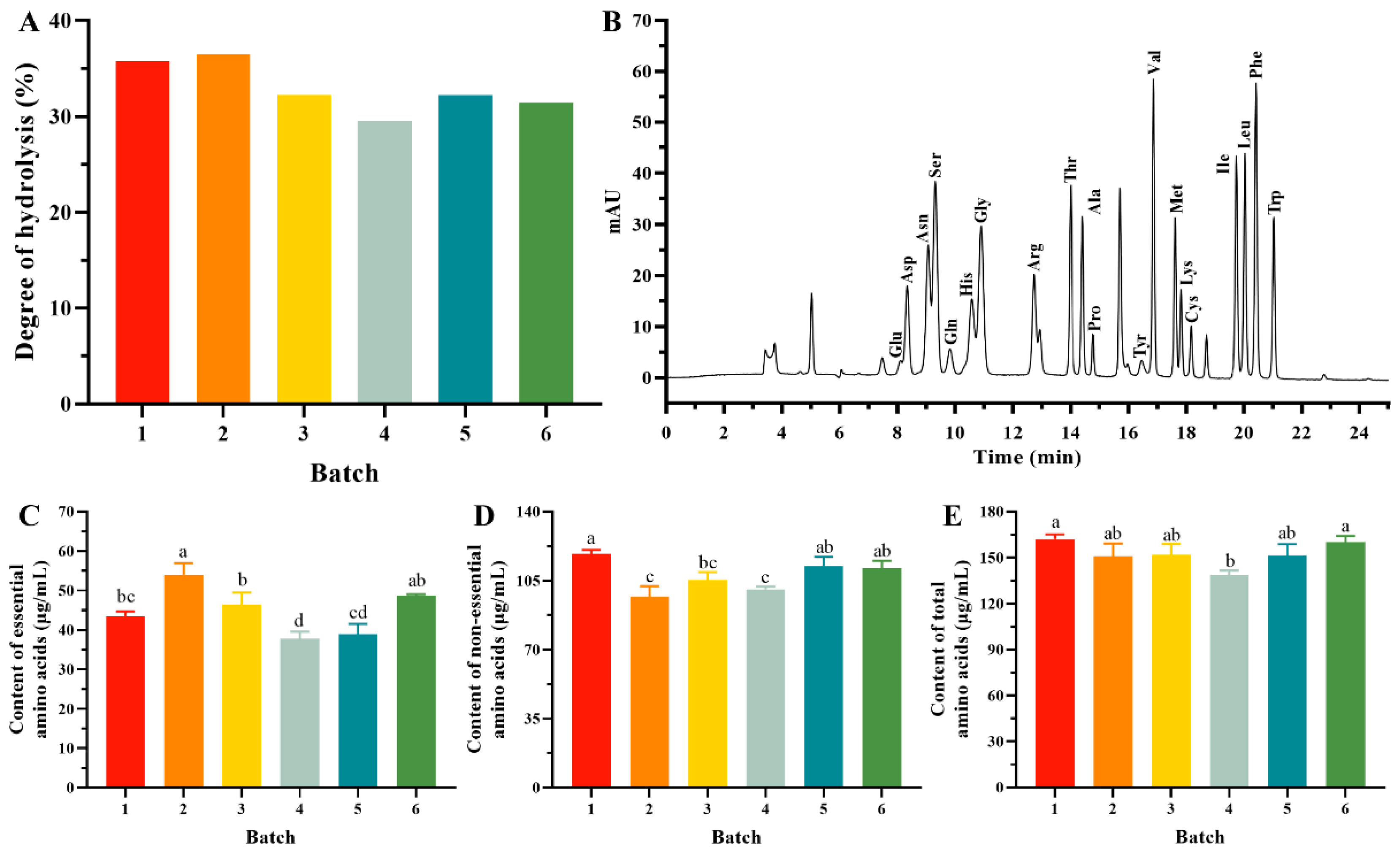
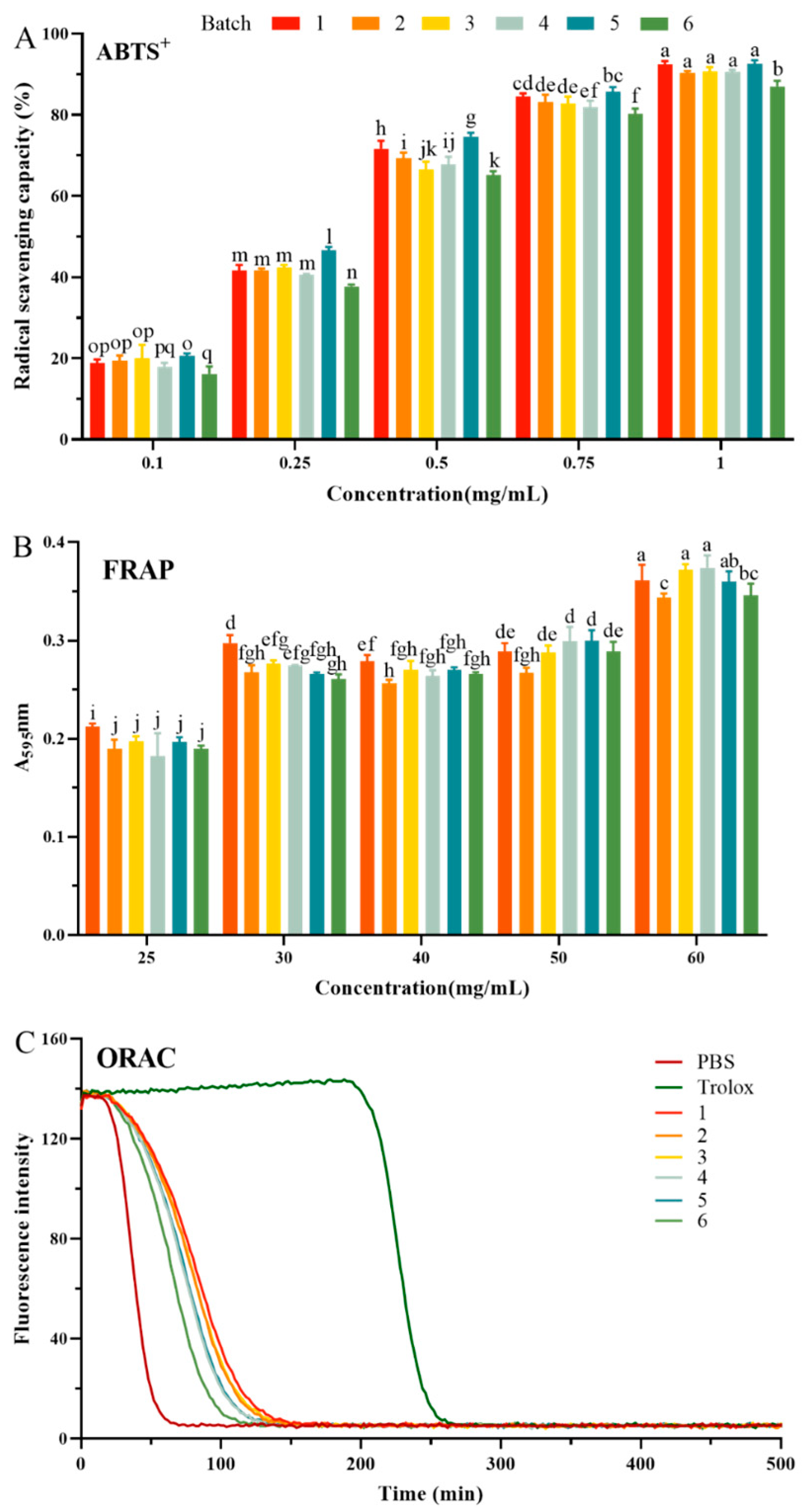
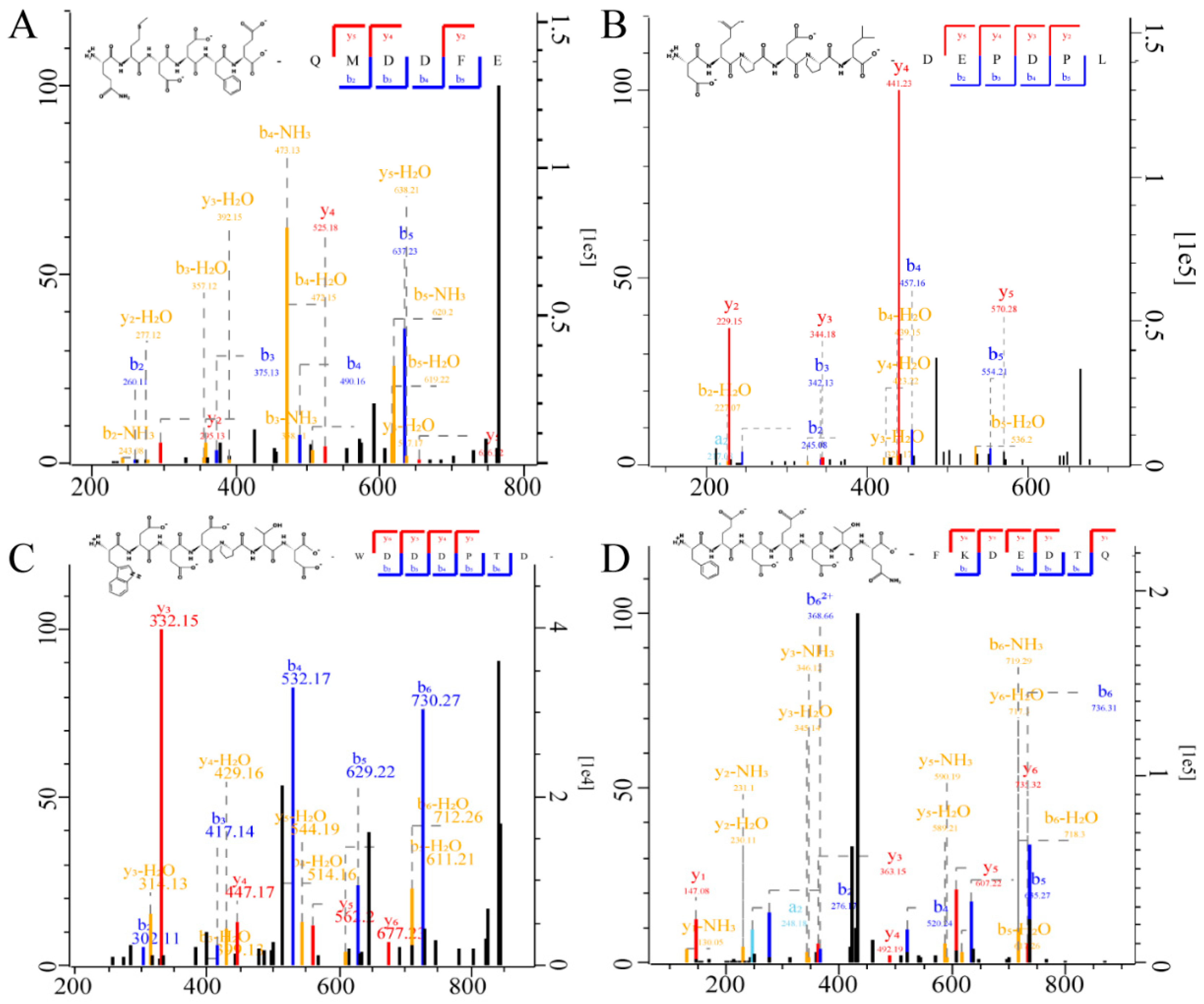
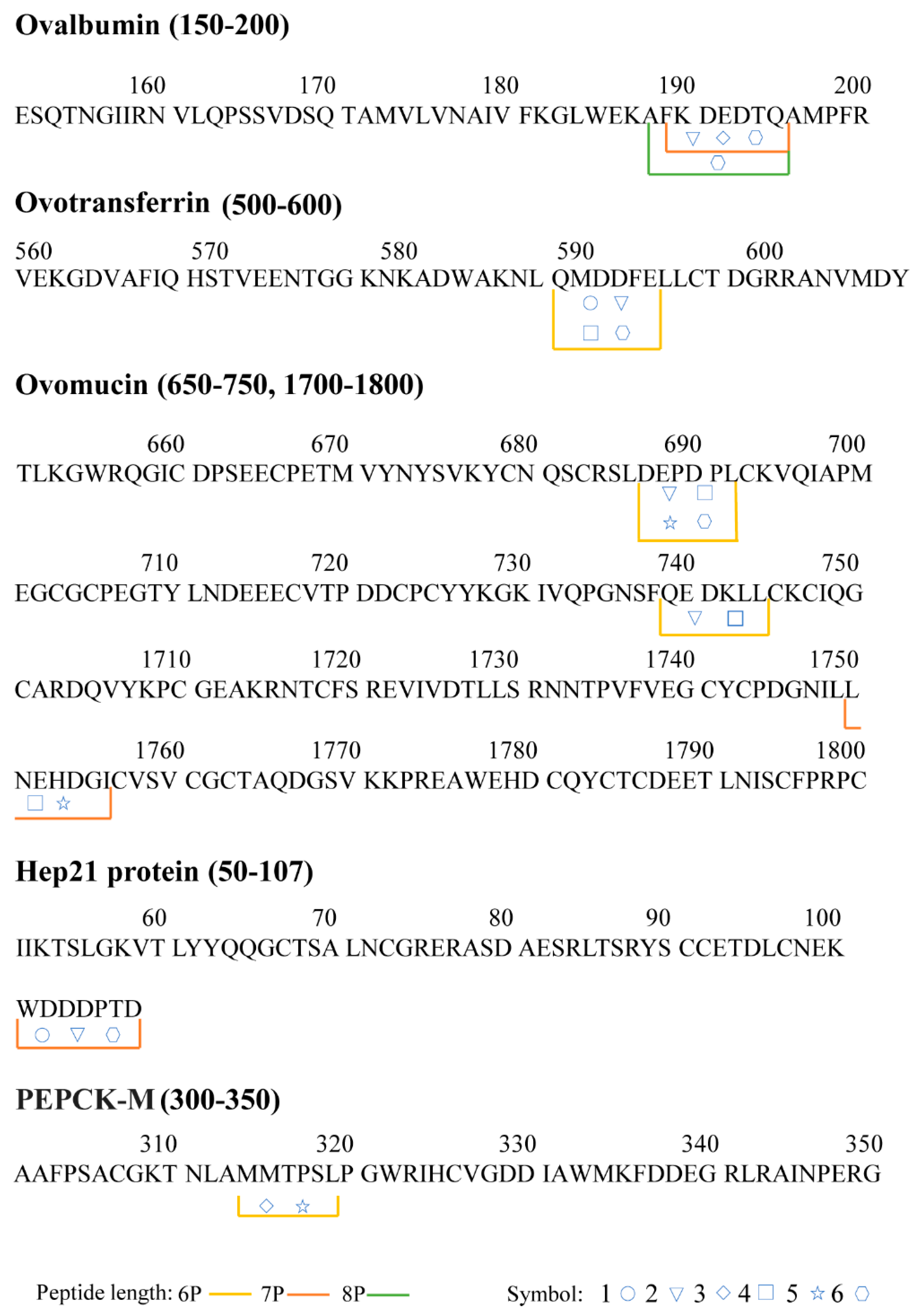
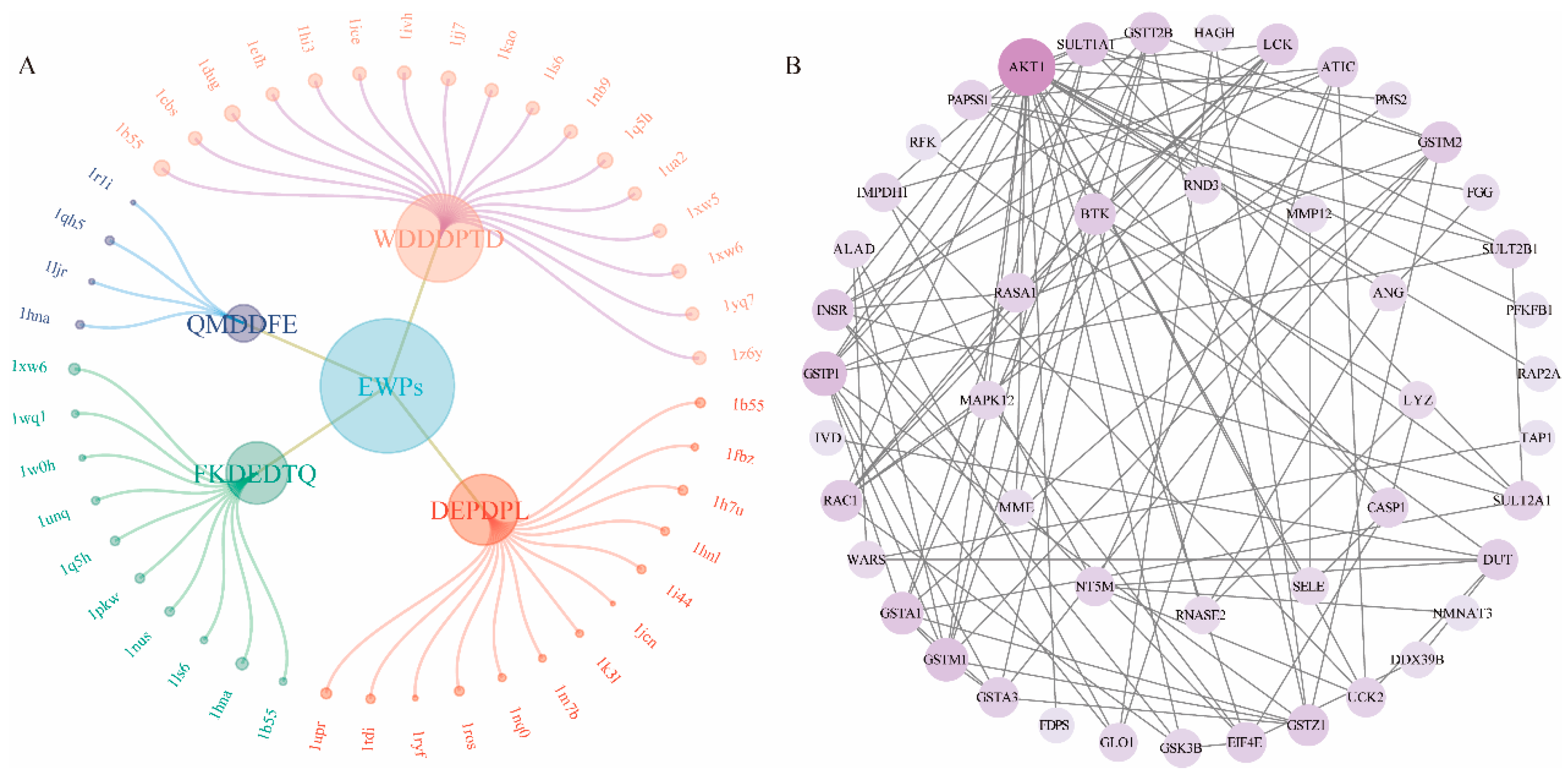
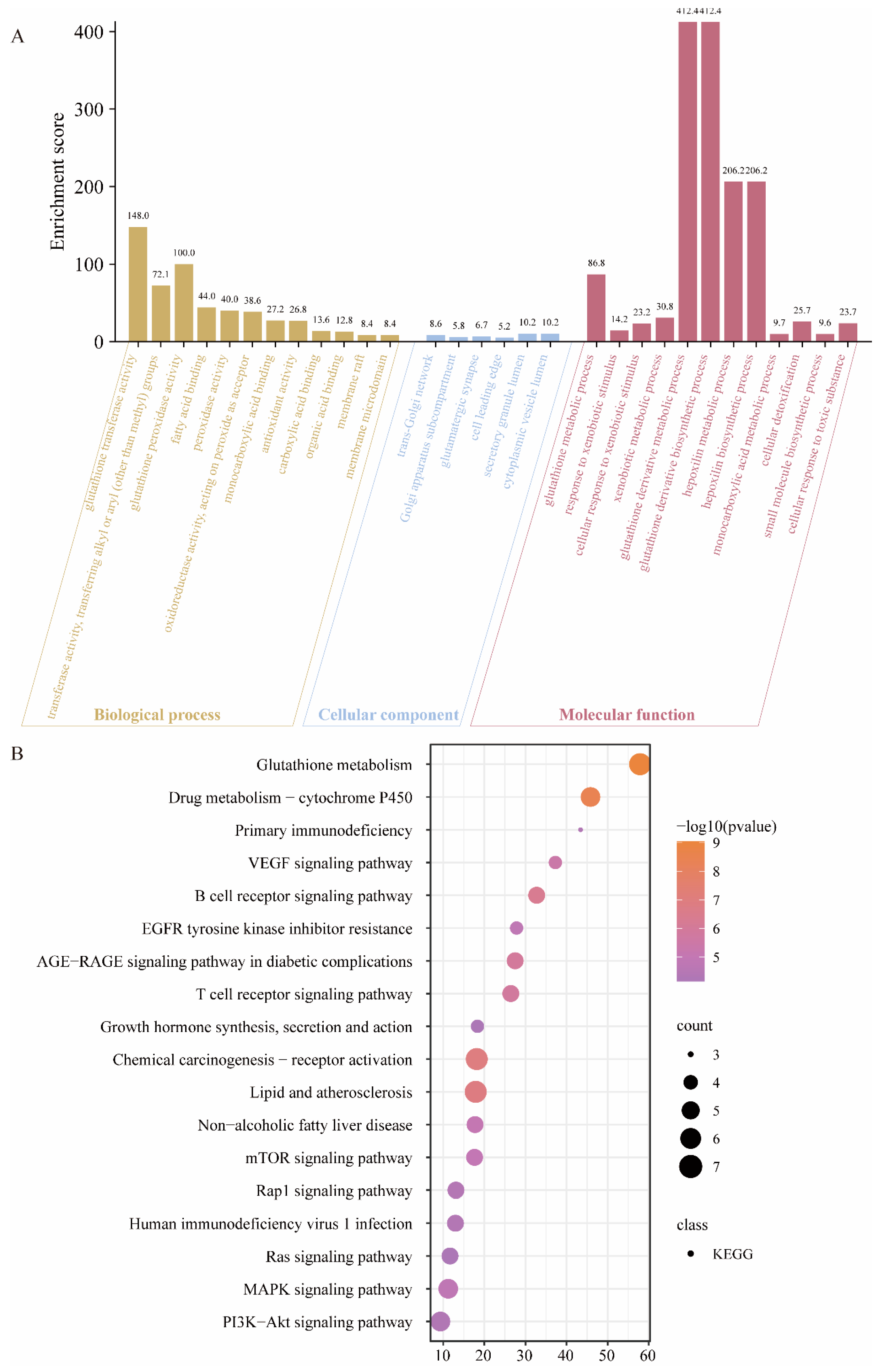
Disclaimer/Publisher’s Note: The statements, opinions and data contained in all publications are solely those of the individual author(s) and contributor(s) and not of MDPI and/or the editor(s). MDPI and/or the editor(s) disclaim responsibility for any injury to people or property resulting from any ideas, methods, instructions or products referred to in the content. |
© 2024 by the authors. Licensee MDPI, Basel, Switzerland. This article is an open access article distributed under the terms and conditions of the Creative Commons Attribution (CC BY) license (https://creativecommons.org/licenses/by/4.0/).
Share and Cite
Lyu, S.; Li, T.; Yang, Q.; Liu, J.; Zhang, T.; Yu, T. Potential Application of Egg White Peptides for Antioxidant Properties: Perspectives from Batch Stability and Network Pharmacology. Foods 2024, 13, 3148. https://doi.org/10.3390/foods13193148
Lyu S, Li T, Yang Q, Liu J, Zhang T, Yu T. Potential Application of Egg White Peptides for Antioxidant Properties: Perspectives from Batch Stability and Network Pharmacology. Foods. 2024; 13(19):3148. https://doi.org/10.3390/foods13193148
Chicago/Turabian StyleLyu, Siwen, Ting Li, Qi Yang, Jingbo Liu, Ting Zhang, and Ting Yu. 2024. "Potential Application of Egg White Peptides for Antioxidant Properties: Perspectives from Batch Stability and Network Pharmacology" Foods 13, no. 19: 3148. https://doi.org/10.3390/foods13193148





